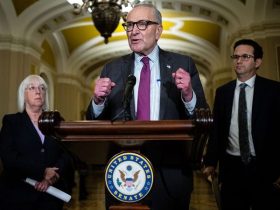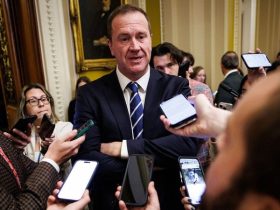Let’s cut through the legal jargon: the Supreme Court yesterday did the only thing it could do, and did it unanimously.
The justices rejected the notion that a Colorado court – all-Democratic appointees – could simply kick Donald Trump off the ballot. Just on the face of it, the idea was ludicrous, absurd and anti-democratic, and the court explicitly banned any other state from trying such a stunt.
On Sunday’s ‘Media Buzz,’ I was griping about the fact that the justices were taking so long, and said they must be honing their opinions and concurring opinions. That turned out to be the case.
In the unsigned opinion, all nine justices declared that ‘nothing in the Constitution requires that we endure such chaos – arriving at any time or different times, up to and perhaps beyond the inauguration.’
While legal observers say the court moved at rocket speed, the ruling came on the last day before voters in Colorado head to the polls, along with those in the other Super Tuesday states.
Much of the back and forth had to do with the 14th Amendment, but put that aside for a moment.
When Colorado’s court first made its ruling, a veritable army of anchors, correspondents and legal analysts, especially on MSNBC, cheered the move, saying Trump was finally being held accountable for fomenting the Capitol riot.
Many of the anti-Trumpers wanted more states to remove the former president from their ballots – as Maine’s Democratic secretary of state did, followed by an Illinois judge late in the game.
That means they were all taking a hard-line stance that has now been rejected Elena Kagan, Sonia Sotomayor and Ketanji Brown Jackson. That should tell us something: Who’s more out of step with the country?
Trump, stepping before the cameras at Mar-a-Lago, calling the ruling a step toward national unity:
‘They worked long. They worked hard. And frankly, they worked very quickly on something that will be spoken about a hundred years from now and 200 years from now. Extremely important.’
Trump then pivoted to the other case the Supreme Court just took, his claims of total unity for actions taken while president. The legal pundits say SCOTUS may well rule against him on that one, though no one knows for sure, which would amount to a split decision on the two high-stakes cases.
Trump was soon doing the greatest hits, attacking such prosecutors as Jack Smith, Letitia James and Fani Willis, and slamming the judges hearing several of his cases.
A New York Times reporter said that Mario Nicolais, attorney for the Colorado side, said the Supremes had ‘abrogated their responsibility to our democracy….I hope that the cowardice of the court today doesn’t lead to bloodshed tomorrow.’ Pretty gracious, huh?
Remember, Kagan, Sotomayor and Jackson found common ground with Sam Alito, Brett Kavanaugh and Clarence Thomas, but the critics are still carping.
Jim Acosta, the anti-Trump CNN anchor, said his antagonist ‘has sort of played the legal system like a fiddle over the last couple of years. He’s thrown the kitchen sink into the gears of America’s judicial system.’
Maine GOP director Jason Savage told the Times that his goal is replacing Secretary of State Shenna Bellows, the Democrat who ruled in December that Trump was ineligible for the Maine ballot: ‘One bureaucrat was trying to alter the presidential election based on her opinion.’
What triggered the entire battle was Colorado dusting off an obscure, little-used legal provision passed after the Civil War: Section 3 of the 14th Amendment. It was aimed at former Confederate officials and soldiers who had rebelled against the country.
Where some of the justices parted company was over the scope of the unsigned opinion, with the court’s three liberal members saying in concurring opinions that the conservative majority went too far in attempting ‘to insulate the court’ and Trump from ‘future controversy….
‘In a sensitive case crying out for judicial restraint, it abandons that course.’
Some of the conflicting views involve whether only Congress has the power to utilize Section 3 and whether the president is considered an officer of the United States.
Justice Amy Coney Barrett agreed with the liberals, saying the majority should not have raised ‘the complicated question whether federal legislation is the exclusive vehicle through which Section 3 can be enforced…
‘This is not the time to amplify disagreement with stridency … Particularly in this circumstance, writings on the court should turn the national temperature down, not up.’
However you slice and dice it, it was a big win for Donald Trump, and for those who believe the voters, not partisan state officials, should get to pick the president.










